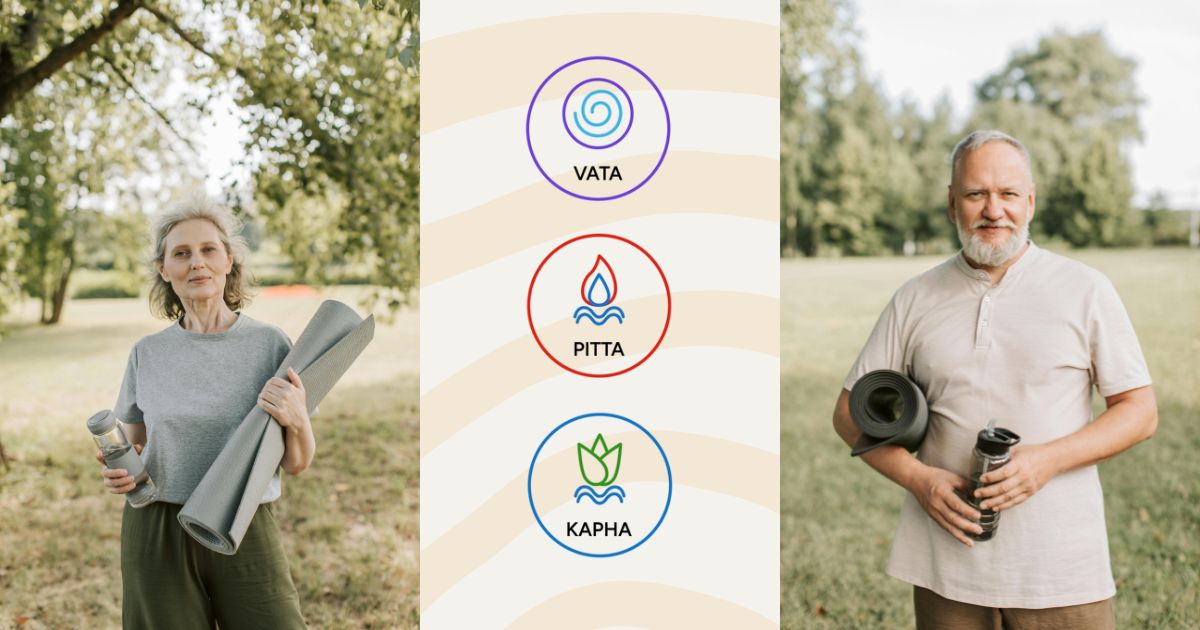
Table of Contents
ToggleWhat's Your Dosha? A Beginner's Guide | Vedicwibes
Curious about Vata, Pitta, and Kapha? This beginner’s guide to Doshas explains how these Ayurvedic energies shape your body, mind, and habits—based on the timeless wisdom of Ashtanga Hridayam.
Have you ever wondered why some people can thrive on just a few hours of sleep while others feel drained without a solid eight? Or why your friend is able to take spicy food in stride while you sweat bullets at the mere presence of a chili?
Ayurveda—India’s traditional science of life—accounts for all of this through a beautifully elegant but profound idea: the Doshas.
Knowing your Dosha is not merely labeling yourself—it’s discovering a plan for living in harmony and striking a balance between your body and nature. In this article,I am not going to inundate you with amorphous lists. Rather,shall guide you through the profound but pragmatic insights of the Ashtanga Hridayam, one of the most important texts of Ayurveda, to assist you in tuning in with your body, mind, and inclinations.
First Things First: What Exactly Is a Dosha?
In Ayurveda, the body is governed by three fundamental energies: Vata, Pitta, and Kapha. These aren’t physical substances like blood or bone, but rather functional energies—patterns that manage how your body and mind operate.
The Ashtanga Hridayam explains that these three Doshas arise from the five elements:
- Vata: Air + Ether (Space)
- Pitta: Fire + a bit of Water
- Kapha: Water + Earth
Each person has a unique balance of these Doshas, typically with one or two being dominant. This constitution, known as your Prakriti, is formed at conception and remains stable throughout life—though lifestyle, diet, and environment can disturb this balance, leading to what’s called Vikriti (your current, possibly imbalanced, state).

Why Doshas Matter More Than You Think
Understanding your Dosha is not about fitting into a neat little category. It’s about knowing how you react to the world—physically, emotionally, and mentally—so you can make choices that restore your balance.For instance:
- A Vata-dominant person who skips meals may feel scattered and anxious.
- A Pitta person who stays up late might wake irritable and hot-headed.
- A Kapha person who oversleeps could end up feeling sluggish and unmotivated.
Ayurveda doesn’t say “this is good” or “this is bad”—it asks, “Is this right for you?”
Let’s Get to Know the Doshas (Beyond the Usual Stereotypes)

1. Vata – The Mover
Air and Ether combine to create Vata, the Dosha responsible for movement—breathing, blinking, heartbeat, nerve impulses, creativity, and flexibility.
How to Recognize Vata Dominance:
- Physically: Thin frame, dry skin, cold hands and feet, quick movements
- Mentally: Very imaginative, loves change, bursts of energy followed by crashes
- Emotionally: Prone to anxiety, fear, and restlessness when out of balance
Strengths:
Quick learning, creativity, spontaneity
Challenges:
Inconsistency, sensitivity to cold, irregular appetite or digestion
When Out of Balance:
Dry skin, constipation, insomnia, racing thoughts, forgetfulness, feeling ungrounded
Vata Wisdom from Ashtanga Hridayam:
Vata is described as light, dry, rough, subtle, mobile, and clear. It increases with age and during times of fasting, excessive activity, or fear. The text places deep emphasis on sthirata—grounding and steadiness—for Vata types.
What Helps:
Warm, nourishing foods, regular routines, oil massage (abhyanga), calming music, and gentle yoga. Avoid raw or cold foods, excessive talking, or late nights.
2. Pitta – The Transformer
Pitta governs digestion, metabolism, and transformation. It is composed of Fire and a bit of Water.
How to Recognize Pitta Dominance:
- Physically: Medium build, sharp features, warm body temperature
- Mentally: Sharp intellect, goal-oriented, competitive
Emotionally: Irritable when hungry, prone to anger or frustration under stress
Strengths:
Leadership, clarity, courage, strong digestion
Challenges:
Tendency to be overly critical, impatient, or intense

When Out of Balance:
Acid reflux, inflammation, skin rashes, irritability, aggression, overheating
Pitta Wisdom from Ashtanga Hridayam:
Pitta is oily, sharp, hot, light, fleshy-smelling, spreading, and liquid. It increases in youth and during midday and summer. The text advises cultivating coolness, calmness, and moderation to manage Pitta’s intensity.
What Helps:
Cooling foods (coconut, cucumber, leafy greens), time in nature, deep breathing, early dinners. Avoid spicy or fried food, overworking, and excessive competition.

3. Kapha – The Stabilizer
Kapha brings structure, lubrication, and immunity. Made from Water and Earth, it gives form and endurance.
How to Recognize Kapha Dominance:
- Physically: Solid build, smooth skin, large eyes, slow metabolism
- Mentally: Calm, nurturing, forgiving
- Emotionally: Can become attached, resistant to change, prone to depression when imbalanced
Strengths:
Loyalty, stability, strength, compassion
Challenges:
Lethargy, weight gain, stubbornness
When Out of Balance:
Congestion, dullness, excessive sleep, water retention, emotional heaviness
Kapha Wisdom from Ashtanga Hridayam:
Kapha is heavy, slow, cool, oily, smooth, dense, soft, and sticky. It increases in childhood and during spring. To balance Kapha, the text encourages lightness, movement, and warmth.
What Helps:
Warm, spicy foods, early wake times, vigorous exercise, dry brushing. Avoid oversleeping, heavy meals, and too much screen time.
Prakriti vs. Vikriti: A Subtle Yet Vital Distinction
Many people make the mistake of identifying with their current imbalance instead of their core nature. This leads to choosing the wrong diet or lifestyle.
Let’s say someone with a Kapha Prakriti eats a lot of sweets and feels lethargic. They might think they’re “too Vata” because they’ve become anxious or restless. But the real issue might be an imbalanced Kapha pushing them to mental and emotional fatigue.
The Ashtanga Hridayam advises the physician to examine both the individual’s nature and their current state to determine the true course of treatment. You can apply this idea in your life: Don’t guess your Dosha based on mood swings—look for lifelong patterns and use professional diagnosis if needed.
But What If I’m Two or All Three?
You’re not alone. Most people are a mix of two Doshas (dual-Prakriti), and a few are tri-doshic. What matters is which Dosha dominates under stress, which traits you’ve had since childhood, and how you respond to certain environments or foods.
For example:
- Vata-Pitta: Energetic and sharp, but needs grounding
- Pitta-Kapha: Strong and calm, but must watch for inflammation or lethargy
- Vata-Kapha: Creative and nurturing, but needs stimulation and warmth
Tri-doshic types are balanced but can fall apart quickly if they deviate from Ayurvedic principles.
Daily Living with Your Dosha in Mind
Here’s how a little Dosha awareness can change everyday choices:
- Wake-Up Time: Vata—early but gently; Pitta—before sunrise; Kapha—definitely before 6 AM
- Meal Timing: Follow regular intervals; Pitta can handle early lunches, Kapha needs lighter dinners
- Exercise: Vata—slow and steady; Pitta—cool and moderate; Kapha—intense and stimulating
- Sleep: Vata—needs wind-down rituals; Pitta—early to bed to avoid midnight heat; Kapha—avoid oversleeping
The Real Takeaway: Self-Awareness Over Self-Correction
Ayurveda is not about fixing yourself—it’s about understanding yourself. The Doshas offer a language to talk about our unique experiences without shame or comparison.
The Ashtanga Hridayam doesn’t preach rigidity. Instead, it urges us to tune into seasonal rhythms, life stages, and our own inner signals. Doshas shift throughout the day, the year, and our life. Your job isn’t to become the “perfect Pitta” or the “ideal Vata”—it’s to create balance in your body, your mind, and your context.
So next time you feel tired, irritable, or bloated, pause and ask: “Which Dosha might be talking to me right now?” Then listen with curiosity, not criticism.
Final Words
Knowing your Dosha is like reading the instruction manual for your body—but one written with warmth, not rules. It’s not about eating “Kapha” food or doing “Pitta” yoga. It’s about discovering how to thrive, naturally.
If you want to go deeper, consider a Dosha consultation or begin a daily journal to track your mind-body responses. You might be surprised how much your Dosha can teach you—about how to live, love, and feel at home in your own skin.
